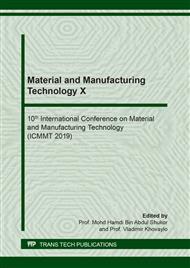p.35
p.40
p.48
p.54
p.59
p.69
p.74
p.80
p.85
The Effect of Stand - Off Distance on the Mechanical Properties of TIG Butt Joints of 316 Stainless Steel
Abstract:
The objective of this study is to investigate and determine the effect of the stand-off distance (distance between the welded plates) on the mechanical properties of the Tungsten Inert Gas (TIG) welded joints. Butt TIG welding was performed for 316 stainless steel (SS) by using different pre welding stand-off distances with fixing the other parameters (thickness of welded plates, voltage, current, groove shape, and scanning speed). The influence of the stand-off distance parameter was examined by using tensile test, hardness test in the three different regions (base metal, heat effected zone, and molten zone), non-destructive testing (including visual inspection, liquid pentrant and X – ray) and microscopic examinations. Results show that the stand-off distance is one of the most important geometrical parameters of the Butt welded joints to end by good mechanical properties. It is found that the optimum stand-off distance was about 1 mm (shows the highest hardness results), but still there were some defects in some spots in the molten metal zone which caused a decrease in the hardness values in these locations. The 2 mm stand-off distance shows reasonable results, and the worst case was recorded for the 0 mm stand-off distance condition. Generally the hardness values of the heat affected zone in all conditions were the highest when compared to both metal welding zone and the base metal zone.
Info:
Periodical:
Pages:
59-65
Citation:
Online since:
March 2020
Keywords:
Price:
Сopyright:
© 2020 Trans Tech Publications Ltd. All Rights Reserved
Share:
Citation:


